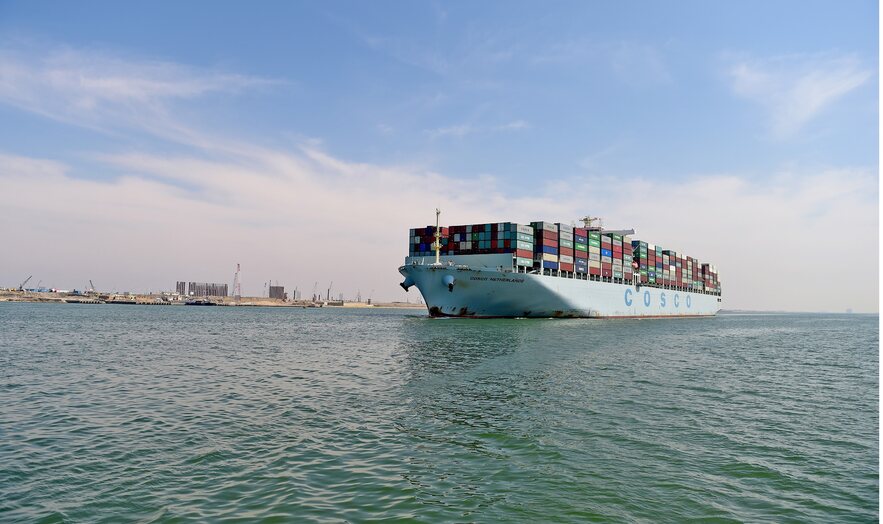The serious disruption caused to traffic flows through the Suez Canal after a container ship went aground, has once again drawn attention to an expanded International North South Corridor (INSTC) as a superior transit option in the years to come.
Russia, Iran, and India have been quietly working on establishing a 7,200 km-long, multimodal trade corridor called INSTC.
As it evolves, the INSTC is adding vital new spurs, fast emerging as a gigantic enterprise, which would link South Asia and West Asia with the beating heart of the Eurasian mainland.
“The North-South corridor is a great option to replace the Suez Canal with a reduction in travel times to 20 days and savings of up to 30 percent,” Iranian Ambassador to Russia Kazem Jalali wrote in a three-language post on his Facebook page late Saturday.
The envoy pointed out that the $9 billion damage to the global economy caused by the Ever Given container vessel, that got struck and blocked international shipping, demonstrates that “the need to speed up the completion of infrastructure and the North-South corridor as an alternative to the route through the Suez Canal has become clear and more important than ever.”
The ultra-bold INSTC project came into being in 2002, when the transport ministers of Russia, Iran, and India signed an agreement to establish a 7200 kilometer multimodal ship, rail and road-based transport network. Starting from Mumbai, it would head to Moscow via Iran and the Caspian Sea.
Currently, the INSTC is set to spread its radials on a much bigger canvass. Essentially, the new INSTC is a combination of two corridors. One starts as originally conceived, from Mumbai and heads to Bandar Abbas, a famous Iranian port in the Gulf. From here it takes the overland route to Bandar Anzali, which is located on the Caspian Sea coast in the north.
Containers are off-loaded here and shipped along the Caspian to its Russian shore at Astrakhan, which becomes the base of further transportation into Eurasia. Over time, other countries are being networked in this rapidly mutating corridor including Azerbaijan and Armenia, in tune with the rise of Eurasia in the 21 st century.
The second corridor, or the Chabahar route also begins at Mumbai, though Gujarat’s upstart Mundra port is now acquiring greater resonance. From India’s west coast, the corridor heads to Chabahar, Iran’s only Indian Ocean port, which is still a work-in-progress with a vast potential. From Chabahar, in which India is pitching major investment, the route heads towards Afghanistan via Iran’s Sistan Baluchistan province along a recent India-built road. Over time, a railway is also envisaged, which will link Chabahar with the Hajigak** iron ore mines in Afghanistan, where India has made major investments.
Planners of the INSTC now want to link the two routes into a giant undertaking that will allow landlocked regions of Eurasia, not only to access the increasingly congested Bandar Abbas, but also the rapidly expanding Chabahar port and route.
Denting allout criticism that India has been wrongly facing about going overboard with the Indo-pacific Quad and abandoning its “strategic autonomy,” New Delhi has actually emerged as a strong votary for the twinning of the two routes, with a vast pan-Eurasian reach.
Last month, India and Iran celebrated Chabahar day, where external affairs minister S. Jaishankar proposed the integration of the Chabahar Port with the INSTC. “I am hopeful that during the INSTC Coordination Council meeting, member-states would agree to the expansion of the INSTC route to include the Chabahar Port and also agree on expanding the membership of this project.”
To develop the composite route further, Russian and Iranian media have been reporting that serious discussions are underway on the construction of a trans-Iranian canal, running from the Persian Gulf to the Caspian Sea.
Analysts, however, say that the plans for a Russian-Iranian trans-Iranian canal are not new. They first emerged in the late 19th century. Ambitious Russian engineers had then charted blueprints for a navigable canal, which would offer Moscow a shorter path to the Indian Ocean, bypassing the Turkish Straits and Egypt's Suez Canal. But political crises and revolutions in both countries had kept the idea frozen. However, with the Suez route once again demonstrating its vulnerability, the idea of an alternative trade passage may have finally arrived.




















